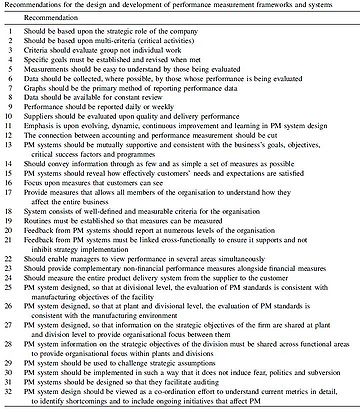Performance Measurement and Performance Management
(→Application) |
(→Annotated Bibliography) |
||
| Line 44: | Line 44: | ||
[3] Nani et al (1990), ''“Strategic control and performance measurement”'', Journal of Cost Management, Summer, pp. 33-42. | [3] Nani et al (1990), ''“Strategic control and performance measurement”'', Journal of Cost Management, Summer, pp. 33-42. | ||
| − | [4] Amaratunga, D. | + | [4] Amaratunga, D. and Baldry, D. (2002) ''“Moving from performance measurement to performance management”'', Facilities, Vol. 20 Issue: 5/6, pp.271-223. |
| + | |||
| + | [5] Bititcti, U.S., Turner, T. and Begermann, C. (2000) ''"Dynamics of performance measurement systems"'', International Journal of Operations and Production Management, Vol.20 No. 6, pp.682-704. | ||
| + | |||
| + | [6] Folan, P. and Browne, J (2004) ''"A review of performance measurement: Towards performance management"'', Computers in Industry, Vol. 56 Issue: 7, pp.663-680. | ||
Revision as of 21:18, 22 September 2017
Contents |
Introduction
Mathematical physicist and engineer Lord Kelvin introduced the notion of “an absolute zero” corresponding to the absolute absence of thermal agitation. The Kelvin scale, named after him, is the scale of the base unit of temperature measurement used in the International System of Units. He has not only impacted the field of thermodynamics but also influenced investigation.
“If you can not measure it, you can not improve it”. This quote by Lord Kelvin highlights the importance of measurement. Measurement in management is essential for continuous improvement. Despite the importance of measurement, taking measurements in project management is not as frequent as it should be. A project can be interpreted from different angles, which leads to the importance of the project manager. It comes to the project manager to set goals, make decisions, stablish the key indicators and parameters to control and monitor the progress of a particular project. Performance measurements must be defined to monitor and, therefore, manage projects to thrive in an organizational context.
This article intends to serve as a guide for future project management practitioners.
Big Idea of Performance Measurement and Management
Performance is defined as the execution of an action [1]. Every action has an impact and the embedded curiosity of humans impels us to analyze, qualitatively or quantitatively, the magnitude of that impact. In a Project management context, analysis entails a successful or unsuccessful management of projects.
In order to analyze, measurements must be made in advance. The definition of goals is the most arduous stage of the measurement process. Sink stated that measurement is a mystery, admitting that is complex, frustrating, difficult, challenging, important, abused and misused [2].
Performance measurement systems are developed in order to monitor and maintain organizational control. This process ensures that an organization pursues strategies that lead to the achievement of overall goals and objectives [3]. The performance measurement is the quantification of the results achieved in relation to the desired goal. The overall performance of an organization is based on social, financial, economic and environment performance and affects the organization’s reputation, meet of expectations and ability to attract and withholding of stakeholders. Although small businesses may be able to operate without setting and measuring goals despite the benefits of this tools, medium-sized businesses and large organizations find this control of processes critical.
Therefore, performance measurement is a powerful tool to achieve a more effective management. Nevertheless, measurements in performance only provides indications about an effect, about what happened. The outcome of these measurements do not provide information about the cause of that result nor what to do about it [4]. Thus, performance management uses performance measurement to refine organizational activities.
Application
Performance measurement offers a framework of results that will be managed and evaluated to improve the operations of an organization in order to align its objective. Therefore, performance measurement forms the basis of organizational management and triggers the possibility to assess the progress towards the organization's defined objectives.
According to Bititcti et al, performance measurement needs to include the following characteristics [5]:
- being sensitive to changes in the external and internal environment of an organization;
- reviewing and reprioritizing internal objectives when the changes in the external and internal environment are significant enough;
- deploying the changes to internal objectives and priorities to critical parts of the organization, thus ensuring alignment at all times;
- ensuring that gains achieved through improvement programmes are maintained.
Annotated Bibliography
[1] Definition of PERFORMANCE. (2017). Merriam-webster.com. Retrieved 22 September 2017, from https://www.merriam-webster.com/dictionary/performance
[2] Sink, D. (1991), “The role of measurement in achieving worl class quality and productivity management”, Industrial Engineering, Vol. 23 No. 6.
[3] Nani et al (1990), “Strategic control and performance measurement”, Journal of Cost Management, Summer, pp. 33-42.
[4] Amaratunga, D. and Baldry, D. (2002) “Moving from performance measurement to performance management”, Facilities, Vol. 20 Issue: 5/6, pp.271-223.
[5] Bititcti, U.S., Turner, T. and Begermann, C. (2000) "Dynamics of performance measurement systems", International Journal of Operations and Production Management, Vol.20 No. 6, pp.682-704.
[6] Folan, P. and Browne, J (2004) "A review of performance measurement: Towards performance management", Computers in Industry, Vol. 56 Issue: 7, pp.663-680.
